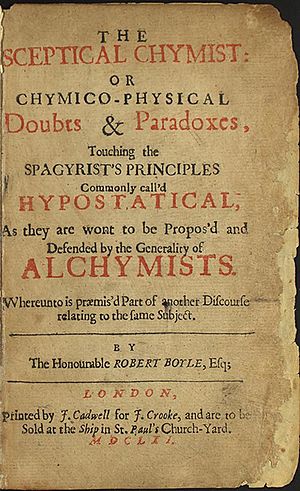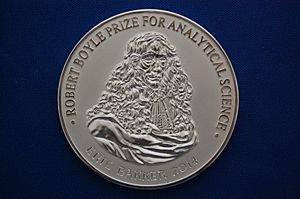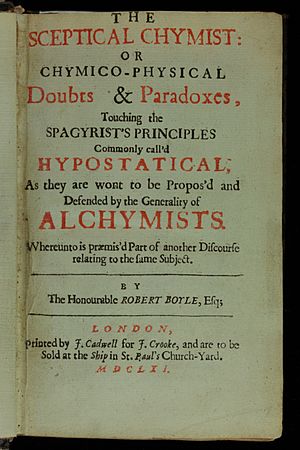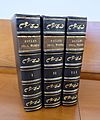Robert Boyle facts for kids
Quick facts for kids
Robert Boyle
|
|
|---|---|
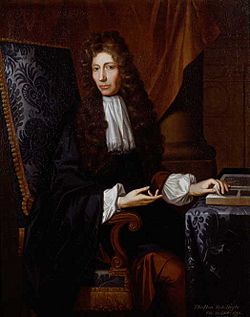
Robert Boyle (1627–91)
|
|
| Born | 25 January 1627 |
| Died | 31 December 1691 (aged 64) |
| Known for | Boyle's law, founder of modern chemistry |
| Awards | Fellow of the Royal Society |
| Scientific career | |
| Fields | Physics, chemistry |
| Influences | Robert Carew, Galileo Galilei, Otto von Guericke, Francis Bacon |
| Influenced | Considered the founder of modern chemistry |
Robert Boyle (1627–1691) was an important scientist from the 17th century. He was a chemist, physicist, and inventor. He also helped start the famous Royal Society in London.
Boyle was born in Ireland into a rich and important family. He was the 14th child of Richard Boyle, the 1st Earl of County Cork. His father came to Ireland in 1588.
Contents
Who Was Robert Boyle?
Boyle's Early Life and Education
Robert Boyle was born at Lismore Castle in County Waterford, Ireland. He was the seventh son and 14th child of Richard Boyle, the 1st Earl of Cork, and Catherine Fenton. His father had become very wealthy and owned a lot of land.
As a young child, Boyle was cared for by a wet nurse. He learned Latin, Greek, and French from private teachers. When he was eight, his mother died. After this, he and his brother Francis went to Eton College in England.
Later, Robert traveled through Europe with a French tutor. In 1641, they visited Italy. They stayed in Florence and studied the ideas of Galileo Galilei. Galileo was an old but still living scientist at that time.
How Boyle Became a Scientist
Robert Boyle came back to England in 1644. He was very interested in science. His father had died the year before and left him land in Dorset and County Limerick, Ireland. Robert lived at Stalbridge House from 1644 to 1652. He set up a laboratory there and did many experiments.
From then on, Robert spent his life on scientific research. He quickly became a key member of a group called the "Invisible College." This group was dedicated to new scientific ideas. They often met in London and Oxford.
In 1652, Robert moved to Ireland. But he found it hard to do his chemistry work there. He wrote that Ireland was "a barbarous country" where it was hard to find chemical tools.
So, in 1654, Boyle moved to Oxford to continue his work. He rented rooms there and focused on his experiments.
Boyle's Famous Air Pump and Law
In 1657, Boyle learned about Otto von Guericke's air pump. With help from Robert Hooke, he improved it. Their new machine, called the "machina Boyleana," was ready in 1659. With it, Boyle started many experiments on air. He even created the term "factitious airs."
In 1660, Boyle published his work on the air pump. The book was called New Experiments Physico-Mechanical, Touching the Spring of the Air, and its Effects.
A critic named Francis Line questioned Boyle's ideas. While answering him, Boyle first mentioned his famous law. This law states that the volume of a gas changes in the opposite way to its pressure. This means if you squeeze a gas, its volume gets smaller. This is now known as Boyle's law.
The Royal Society and New Ideas
In 1663, the Invisible College became the Royal Society. This was a major scientific group in London. King Charles II of England made Boyle a member of its council. Boyle was asked to be president in 1680, but he said no.
Boyle also made a list of 24 inventions he wished for. These included "the art of flying" and "perpetual light." Most of these ideas have now come true!
In 1668, Boyle moved to London. He lived with his older sister, Katherine Jones, Viscountess Ranelagh. She had a laboratory at her home. They worked together on science for many years. Katherine was a big influence on his work.
Boyle's Later Years and Legacy
Boyle's health was never very strong. In 1669, it got worse. He started to do fewer public events. He wanted more time to organize his papers and work on important chemistry ideas.
His health got even worse in 1691. He died on December 31, just a week after his sister Katherine passed away. Boyle died from paralysis. He was buried in London. In his will, Boyle set up a series of lectures called the Boyle Lectures.
What Were Boyle's Main Contributions?
Robert Boyle is most famous for Boyle's law. This law helps us understand how gases behave.
He hired Robert Hooke as an assistant. They worked together on experiments, especially with the air pump.
Boyle was also part of the group that founded the Royal Society in 1660. This society helped share new scientific discoveries.
Boyle studied alchemy, which was an old form of chemistry. But he is also seen as the first modern chemist. His 1661 book, The Sceptical Chymist, was very important for the history of chemistry. It helped change how people thought about chemical elements.
Boyle's Religious Beliefs
Boyle was a very religious person. He was a director of the East India Company. He spent a lot of money helping to spread Christianity in the East. He gave money to groups that sent missionaries. He also paid for the Bible to be translated into different languages.
Boyle believed that everyone should be able to read the Bible in their own language. This was different from the Catholic Church at the time, which mostly used Latin.
Awards and Honours for Robert Boyle
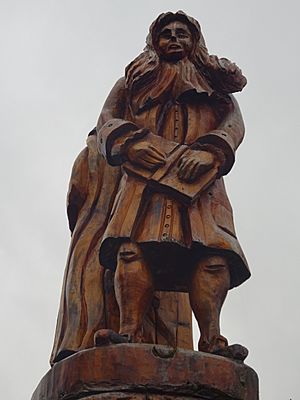
As a founder of the Royal Society, Robert Boyle became a Fellow of the Royal Society (FRS) in 1663.
Boyle's law is named after him. The Royal Society of Chemistry gives out a Robert Boyle Prize for Analytical Science. This award is also named in his honor.
The Boyle Medal for Scientific Excellence in Ireland started in 1899. It is given by the Royal Dublin Society. Also, the Robert Boyle Summer School began in 2012 to celebrate his legacy.
Important Books by Robert Boyle
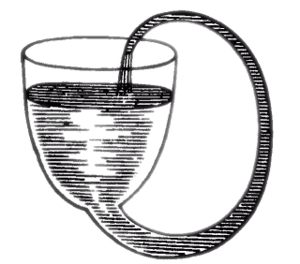
Here are some of his most important scientific books:
- 1660 – New Experiments Physico-Mechanical: Touching the Spring of the Air and their Effects
- 1661 – The Sceptical Chymist
- 1662 – A Defence of the Authors Explication of the Experiments (an addition to his air pump book)
- 1663 – Considerations touching the Usefulness of Experimental Natural Philosophy
- 1664 – Experiments and Considerations Touching Colours
- 1665 – New Experiments and Observations upon Cold
- 1666 – Hydrostatical Paradoxes
- 1666 – Origin of Forms and Qualities according to the Corpuscular Philosophy (This book included the first description of decompression sickness in a viper in a vacuum.)
- 1669 – A Continuation of New Experiments Physico-mechanical
- 1670 – Tracts about the Cosmical Qualities of Things
- 1672 – Origin and Virtues of Gems
- 1673 – Essays of the Strange Subtilty, Great Efficacy, Determinate Nature of Effluviums
- 1674 – Two volumes of tracts on the Saltiness of the Sea
- 1674 – Animadversions upon Mr. Hobbes's Problemata de Vacuo
- 1676 – Experiments and Notes about the Mechanical Origin or Production of Particular Qualities
- 1678 – Observations upon an artificial Substance that Shines without any Preceding Illustration
- 1680 – The Aerial Noctiluca
- 1682 – New Experiments and Observations upon the Icy Noctiluca
- 1684 – Memoirs for the Natural History of the Human Blood
- 1685 – Short Memoirs for the Natural Experimental History of Mineral Waters
- 1686 – A Free Enquiry into the Vulgarly Received Notion of Nature
- 1690 – Medicina Hydrostatica
- 1691 – Experimenta et Observationes Physicae
He also wrote books about religion and philosophy, including:
- 1648/1660 – Seraphic Love
- 1663 – Some Considerations Touching the Style of the H[oly] Scriptures
- 1664 – Excellence of Theology compared with Natural Philosophy
- 1665 – Occasional Reflections upon Several Subjects
- 1675 – Some Considerations about the Reconcileableness of Reason and Religion
- 1687 – The Martyrdom of Theodora, and of Didymus
- 1690 – The Christian Virtuoso
Images for kids
See also
 In Spanish: Robert Boyle para niños
In Spanish: Robert Boyle para niños


